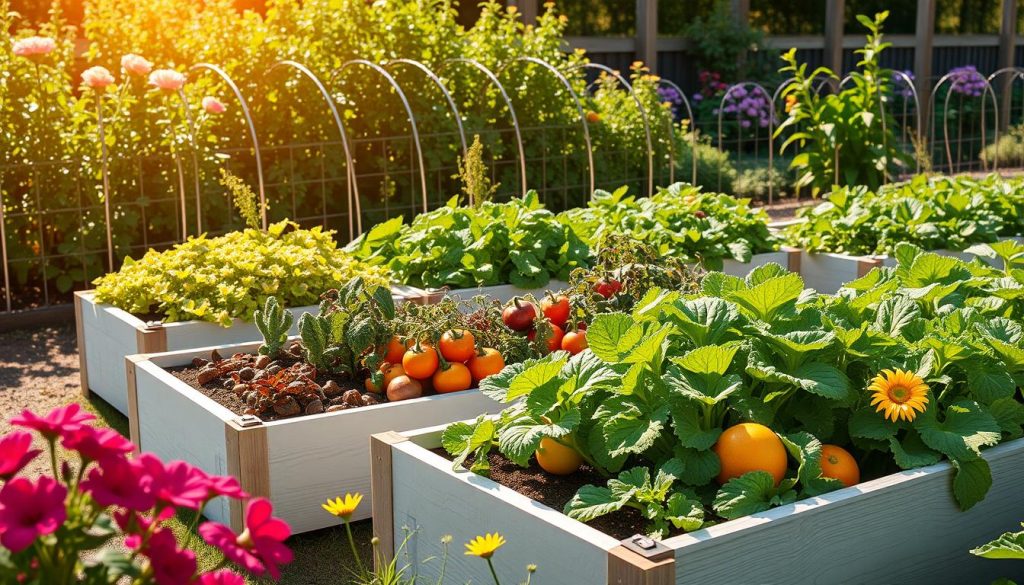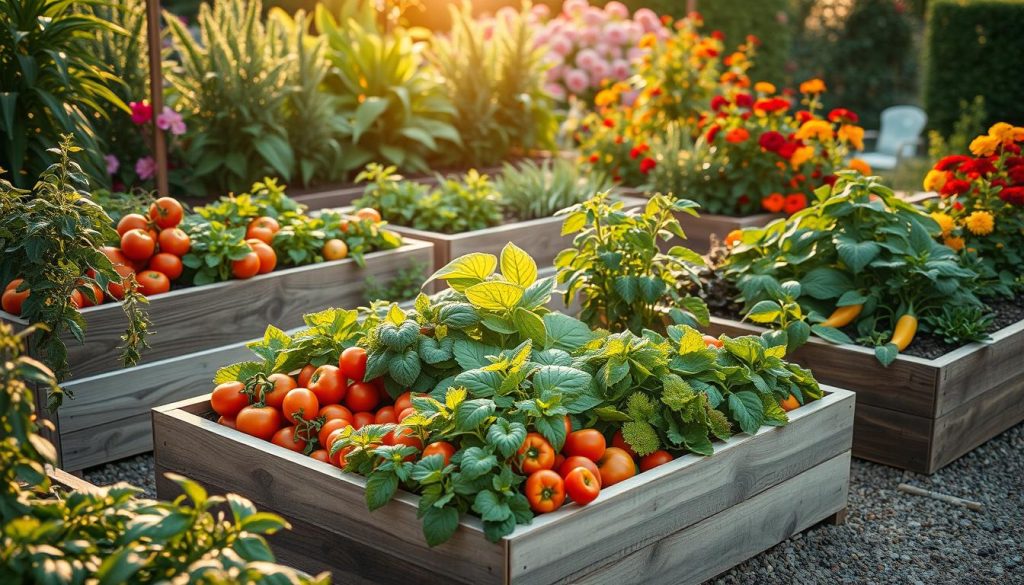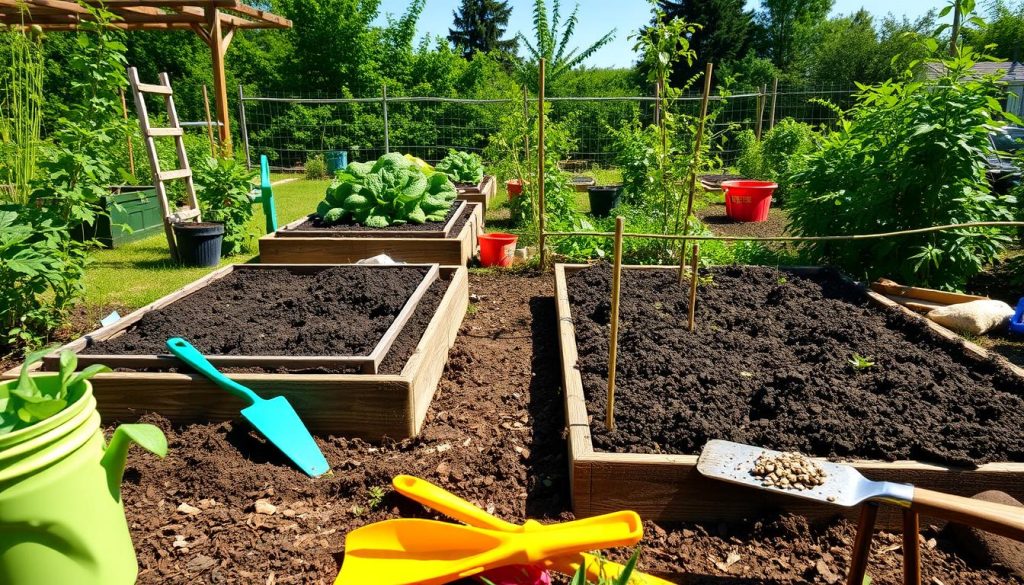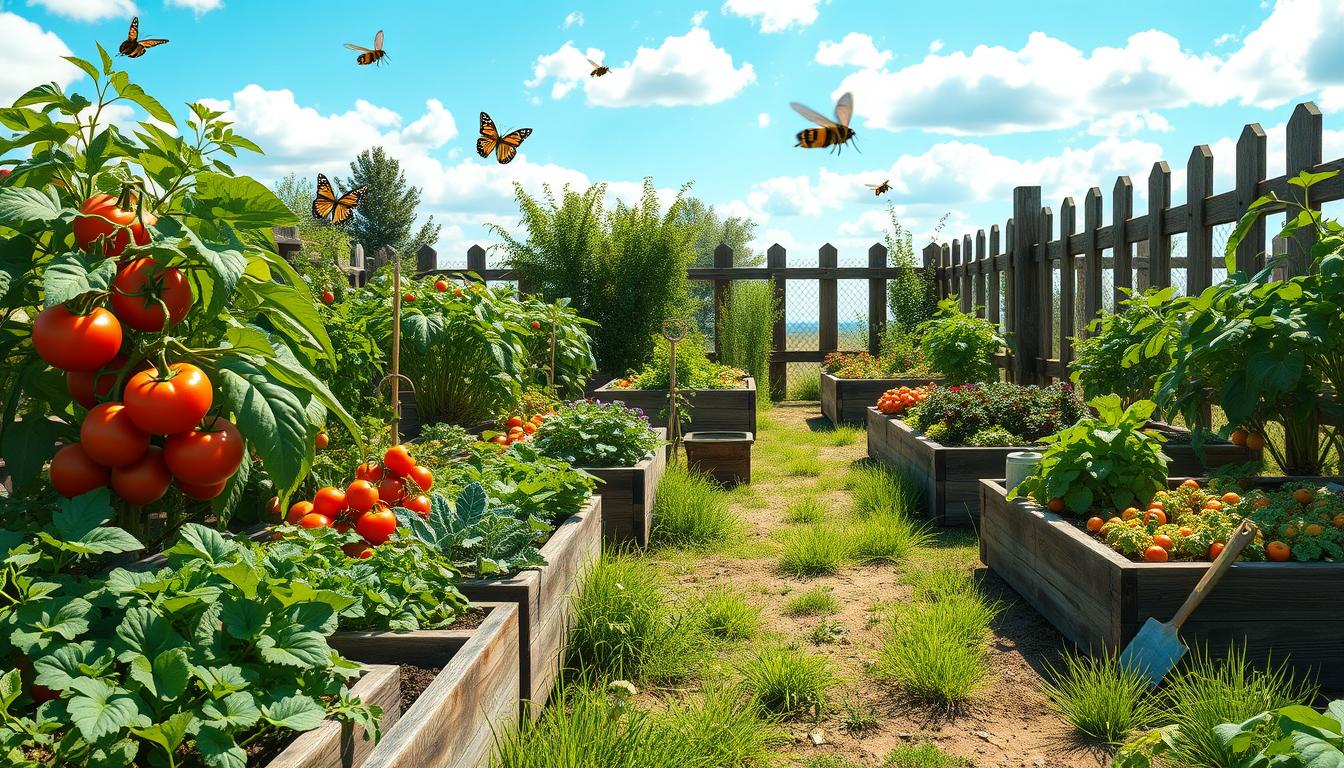I’m excited to share my personal experience with raised bed vegetable gardening. It’s a great way to grow your own food. It’s perfect for both beginners and experienced gardeners, offering a bountiful harvest with the right techniques.
In this guide, I’ll give you the info you need to start and succeed in raised bed vegetable gardening. We’ll cover preparation, planting, and maintenance. By following these tips, you’ll enjoy fresh, homegrown vegetables from your own raised bed garden.
Raised bed vegetable gardening works well in any space, whether it’s a small backyard or a large plot. With the right approach, you can enjoy a successful harvest.
What is Raised Bed Vegetable Gardening?
Raised bed vegetable gardening is a popular way to grow veggies. It has many benefits, like better soil and more crops. Gardeners get better drainage and soil quality, making it easy to grow many veggies.
Raised beds are made of wood, metal, or composite. They create a perfect spot for plants to grow well.
Some key benefits of raised bed gardening include:
- Soil structure improves, helping roots grow and water soak in.
- Crop yields go up because of the better soil and controlled environment.
- Soil erosion is less, keeping soil and nutrients in place.
There are many veggies you can grow in raised beds. From leafy greens to root veggies, the options are endless. Raised beds make gardening productive, even in small spaces.

Raised bed gardening is a smart choice for growing healthy veggies. It also helps the environment and reduces waste. With raised beds, gardeners can have a sustainable garden that keeps giving fresh produce for years.
Choosing the Right Location for My Garden
When you start a raised bed garden, picking the right spot is key. Raised beds let you control the environment. But, you still need to think about sunlight, water, and drainage. A well-planned raised bed garden can make your soil better and help your crops grow more.
Sunlight Requirements
Most veggies need at least 6 hours of direct sunlight a day. When picking a spot for my garden, I look at how much sunlight it gets. Here are some things to keep in mind:
- South-facing spots get the most sunlight
- East- and west-facing spots get some sunlight
- North-facing spots get the least sunlight
Proximity to Water
Having water close by is important for raised bed gardening. I pick a spot that’s easy to get to for watering.

Impact of Drainage
Good drainage is key to stop waterlogging in raised beds. I design my garden with drainage in mind. This way, the soil won’t get too wet, which can harm the roots.
| Factor | Consideration |
|---|---|
| Sunlight | At least 6 hours of direct sunlight |
| Water | Easy access to a water source |
| Drainage | Proper drainage to prevent waterlogging |
Materials for Building My Raised Beds
Building raised beds for my vegetable garden offers many options. I’m looking at each material’s benefits and how they’ll help my garden. I aim for durability, ease of care, and a great environment for my plants.
Choosing the right materials is key for success in raised bed gardening. Wood is a favorite, with cedar and pine being top picks. Here’s a look at their pros and cons for a successful garden:
Wood Options: Cedar vs. Pine
- Cedar fights off rot and insects well, making it ideal for raised beds.
- Pine is cheaper but might need extra care to avoid rot and pests.
Alternatives: Metal and Composite Materials
Metal and composite materials are also good choices. They’re tough, easy to care for, and eco-friendly. Yet, they might cost more and can get hot in the sun, harming plants.

How to Line My Raised Bed
Line my raised bed to stop weeds and keep moisture in. I can use landscape fabric, plastic, or old cardboard. These steps help my garden grow well.
| Material | Pros | Cons |
|---|---|---|
| Wood | Durable, natural, and looks good | Can rot and be damaged by insects |
| Metal | Durable, low-maintenance, and eco-friendly | Can be pricey and gets hot in the sun |
| Composite | Durable, low-maintenance, and eco-friendly | Can be pricey and gets hot in the sun |
Preparing the Soil for Planting
Preparing the soil for raised bed vegetable gardening is key. The best mix depends on the vegetables you’re growing. A mix of topsoil, compost, and perlite or vermiculite is usually best. It ensures good drainage, aeration, and water retention.
To get the most out of raised bed gardening, follow some important steps. Adding compost or manure is crucial. It improves soil structure and fertility. Aim for a 2-3 inch layer of compost or manure in the soil.
Soil Composition: What’s Best?
A balanced soil mix is essential for growth. The main components are:
- Topsoil: gives nutrients and support
- Compost: adds organic matter and improves structure
- Perlite or vermiculite: boosts drainage and aeration
Adding Organic Matter
Organic matter is vital in raised bed gardening. It helps by:
- Enhancing soil structure
- Increasing fertility
- Supporting beneficial microorganisms

Soil Testing and Amending
Soil testing is a must before planting. It reveals any nutrient gaps or pH issues. Based on the results, you can adjust the soil with fertilizers or pH adjusters. This creates the best environment for your vegetables.
Selecting Vegetables for My Raised Bed
Choosing the right vegetables for raised beds can be tough, especially for beginners. You need to think about your climate, soil, and what you like. Raised beds help with soil quality and drainage, making plants healthier and more productive.
For beginners, start with easy-to-grow veggies like lettuce, spinach, cherry tomatoes, and radishes. They grow fast and do well in raised beds. Also, remember to plant veggies together wisely to avoid pests and diseases. For example, marigolds with tomatoes can keep nematodes away, and basil and mint can make nearby veggies taste better.
Knowing when to plant is key. Cool-season crops like broccoli, kale, and carrots do best in spring or fall. Warm-season crops like peppers, eggplants, and okra love summer heat. Planting at the right time ensures a steady harvest from your raised beds.
- Leafy greens (lettuce, spinach, kale)
- Cherry tomatoes
- Radishes
- Broccoli
- Peppers
By picking the right veggies and following some tips, you can have a great harvest. Whether you’re new to gardening or experienced, raised beds offer a fun and tasty way to grow your own food.
| Vegetable | Season | Maturity Days |
|---|---|---|
| Lettuce | Cool | 40-50 |
| Tomatoes | Warm | 60-90 |
| Radishes | Cool | 20-30 |
Planting Techniques I Use
Raised bed gardening offers many benefits, and planting is a key step. A well-planned design can greatly improve your garden’s success. I’ll share the pros and cons of direct seeding versus transplants and offer tips on spacing.
I’ve tried both direct seeding and transplants. Direct seeding works well for seeds like carrots and radishes. For seeds like tomatoes and peppers, starting them indoors as transplants is better.
Direct Seeding vs. Transplants
When choosing between direct seeding and transplants, consider these points:
- Seed type: Some seeds do better when sown directly, while others need to be transplanted.
- Soil temperature: Certain seeds need a specific soil temperature to grow.
- Moisture: Seeds need consistent moisture to germinate.
Proper Spacing for Growth
Proper spacing is crucial for healthy plants and high yields. I ensure there’s enough room between plants for air and sunlight.
Using Mulch to Retain Moisture
Mulch helps keep the soil moist and controls weeds. I use organic mulch like straw or wood chips to keep my soil healthy.
Watering Strategies for My Raised Beds
Watering is key in raised bed gardening. The right approach can greatly improve plant health and productivity. When it comes to vegetable gardens, many overlook watering. But it’s crucial for a successful garden.
Finding the right balance between enough moisture and avoiding too much is essential. This balance is the secret to successful watering.
Frequency of Watering
The timing of watering depends on weather, soil, and plant needs. Generally, I water when the top inch of soil feels dry. This can be every day in hot weather or less often in cooler times.
Best Methods: Drip Irrigation vs. Hand Watering
Drip irrigation is great for watering raised beds. It sends water straight to the roots, cutting down on evaporation and runoff. But hand watering works well for smaller gardens too.
Using a soaker hose or a watering can with a long spout helps. These tools ensure water reaches the roots, reducing waste.
How to Prevent Overwatering
To avoid overwatering, I regularly check soil moisture. I also skip watering during heavy rain. Mulch helps keep moisture in the soil and cuts down on evaporation.
By following these tips and using the right watering methods, my raised bed garden thrives. Some ideas include using beds with built-in water reservoirs or self-watering planters. These reduce the need for frequent watering.
Pest Control in My Garden
Enjoying raised bed vegetable gardening has taught me about pest control. Organic pest management is key to a healthy garden. It keeps pests away while protecting our environment.
Organic Pest Management Practices
I use organic methods to manage pests in my garden. This includes introducing beneficial insects and using physical barriers. Good garden hygiene is also crucial. These practices are safe for the environment and effective against pests.
Common Pests to Look For
Watch out for aphids, whiteflies, and spider mites in your garden. Regular checks help catch pest problems early. This way, you can stop them from getting worse.
Companion Planting for Pest Control
Companion planting is a great way to control pests. Plants like marigolds and basil repel pests naturally. They can be planted with vegetables to keep pests away.
Here are some examples of companion planting for pest control:
- Planting marigolds with tomatoes to repel nematodes
- Planting basil with peppers to repel aphids
- Planting radishes with cucumbers to repel cucumber beetles
Seasonal Maintenance Tips for Raised Beds
To keep my raised garden beds for vegetables thriving, I focus on seasonal maintenance. I prepare for winter, do a spring cleanup and planting, and take care in mid-season. These steps help me get a good harvest and keep my beds healthy.
Preparing for Winter
When the growing season ends, I get my raised beds ready for winter. I clean up debris, add mulch, and protect the soil from erosion. This makes my beds ready for spring.
Spring Cleanup and Planting
In spring, I remove winter mulch and debris, and add fresh soil amendments. Then, I plant new crops, rotating vegetables to keep the soil healthy. This keeps my garden beds in top shape.
Mid-Season Care
During the growing season, I focus on mid-season care. I weed, fertilize, and watch for pests. This keeps my harvest strong and my beds healthy.
Harvesting My Vegetables
Standing back, I admire my thriving raised bed vegetable garden. I feel proud and satisfied. The time and effort I’ve put in have paid off, and now it’s time to enjoy the harvest. I wait until my vegetables are at their peak ripeness for the best flavor and nutrition.
When it’s time to harvest, I follow best practices. I gently pluck or snip the produce, being careful not to damage the plant. I store my harvested goods in the fridge or a cool, dark place. This keeps them fresh and flavorful, letting me enjoy them for days.
Raised bed gardening has changed how I see food. Growing my own vegetables has made me appreciate fresh, homegrown produce more. Each bite reminds me of the joy and accomplishment of gardening. This experience has inspired me to keep learning about raised bed gardening and gardening tips.

